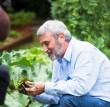Yucca elephantipes, more commonly called the spineless or soft-tipped yucca, is a fast growing member of the agave family. In fact, it can quickly outgrow its original position in the garden, as seen in our segment.
Don showed how to prune the yucca without ruining its architectural shape. He then used some of the pruned pieces to strike cuttings for other parts of the garden or as potted specimens.
Plant details:
Yucca elephantipes is a small evergreen tree reaching around 9 metres (30′) in the wild, but it is usually smaller in cultivation. It develops a thick, branching trunk which is reminiscent of an elephant’s foot at the base. From summer to autumn it produces white, bell-shaped flowers in large panicles. The spineless yucca is adaptable to a wide range of climates and conditions and is drought, salt and frost tolerant. It can be grown indoors as an architectural pot plant, or outdoors as a landscaping plant. It is suitable for modern, Santa Fe or Mediterranean style houses and landscapes.
Taking your cutting:
In the warmer parts of Australia, yucca cuttings can be taken almost anytime of the year. In the cooler zones like Victoria, take cuttings from December to May.
First, tidy up the clump by stripping the lower leaves off the stems. Stripping the leaves will also prevent the cutting from losing its moisture before the roots grow.
Take your cutting from a mature stem, with brown bark underneath the stripped section. If the bark is cream-coloured, rotting may occur.
The cutting can be taken from any part of the stem. The thickness and length of the stem doesn’t matter.
The foliage at the tip of the cutting does not need pruning.
Allow the stem to dry out for a few days to a week in a shady spot.
After drying out, put the cane in an appropriate-sized pot filled with a free-draining mix. (Don used two parts seed-raising mix to one part river sand.) No hormone powder is necessary.
Keep the pot moist and store in a shady spot with plenty of light. (Tip: make sure you tie the cutting to something after it is potted, as it may fall over in the wind.)
Roots should form in about four weeks. Do not re-pot until you see roots in the drainage holes of the pots.
Further information
Yuccas are readily available at nurseries Australia-wide. Expect to pay from $35 for a 200mm (8″) pot to around $250 for a 2m tall plant.
A 30 litre bag of seed-raising mix costs around $12.
A 25 kg bag of river sand costs about $5.



